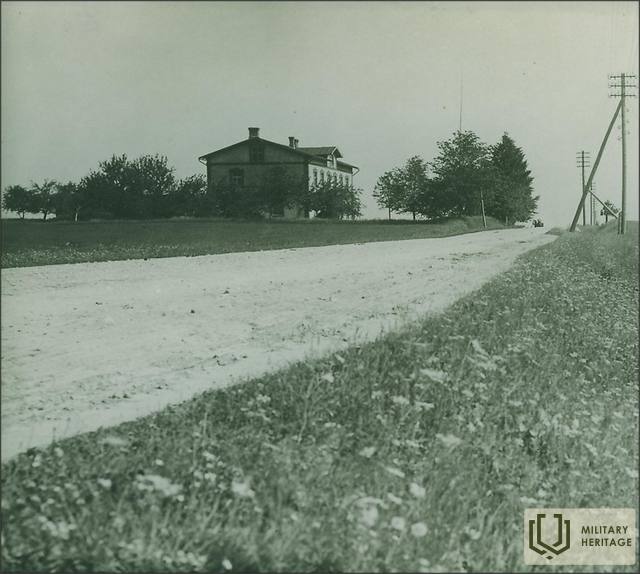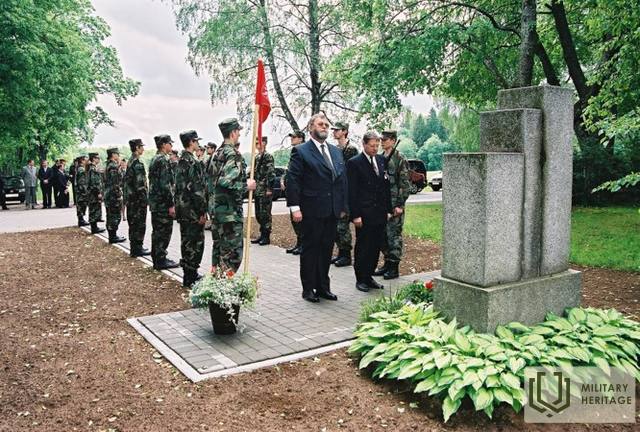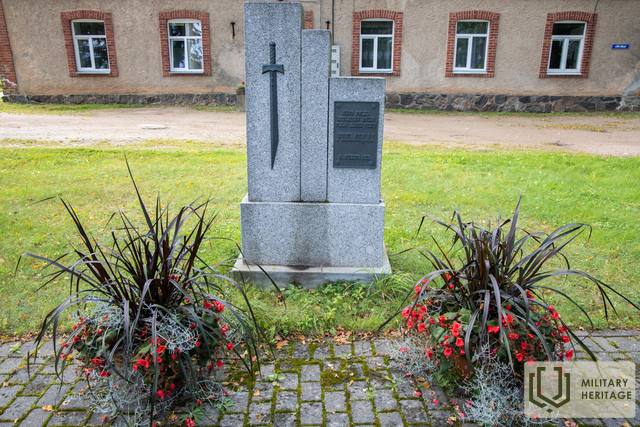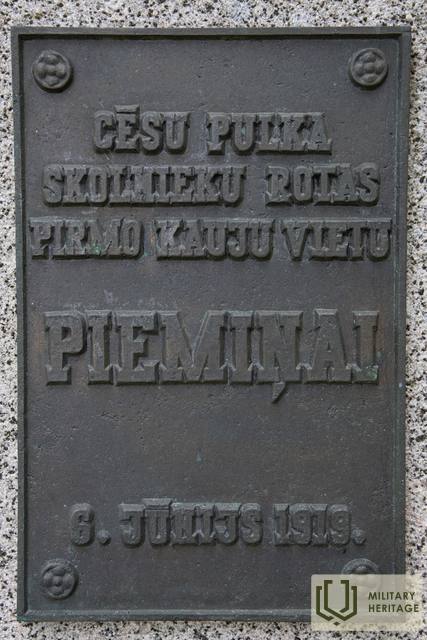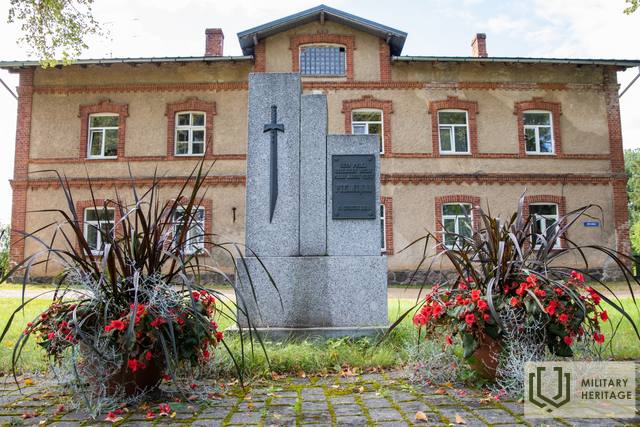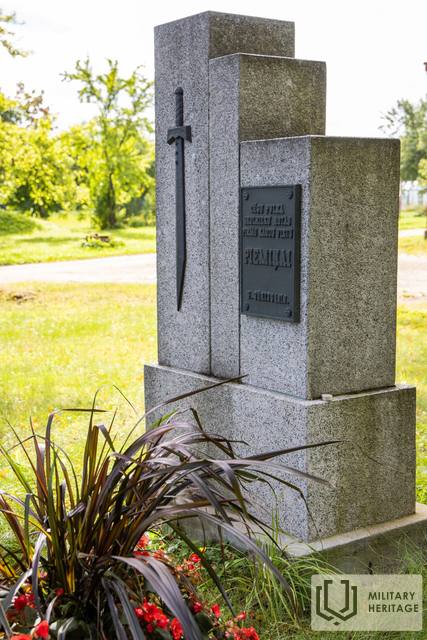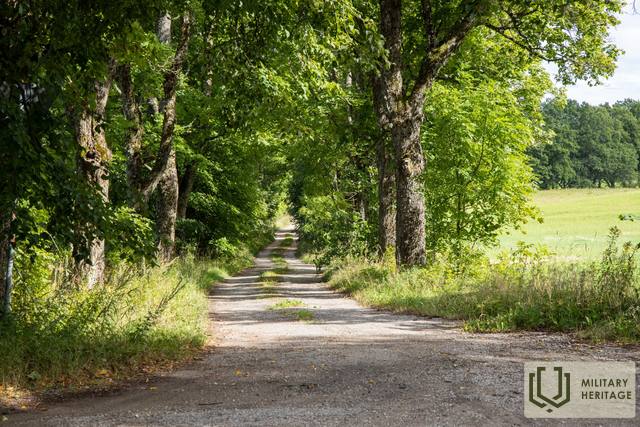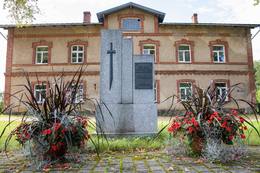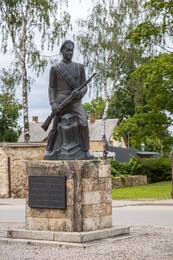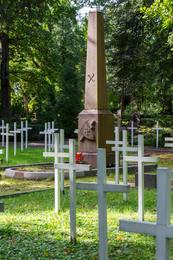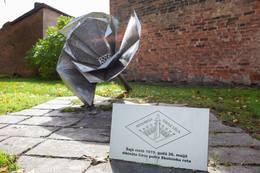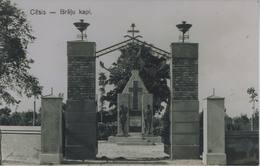Cēsu pulka skolnieku rotai veltītais piemineklis pie bijušā Līvu pagasta nama

1919. gada Cēsu kaujās piedalījās Cēsu pulka brīvprātīgo skolnieku rota, kas kā kaujas vienība no 108 Valmieras un Cēsu skolu jauniešiem noformējās 5. jūnijā Cēsu proģimnāzijas telpās. Jau naktī no 5. uz 6. jūniju, kādu stundu pēc pusnakts, bija trauksme un rotai deva pavēli iziet uz pozīcijām. Rota izgāja līnijā Mācītājmuiža – Meijermuiža, kas skaitījās svarīgākais kaujas iecirknis.
Pirmajā kaujā vairākus skolniekus ievainoja, bet valmierietis Edgars Krieviņš no ļoti smaga ievainojuma vēderā tajā pašā dienā nomira. Viņu 13. jūnijā ar kareivisku godu apglabāja Valmieras Pilsētas kapos. Edgaru Krieviņu pēc nāves apbalvoja ar Lāčplēša Kara ordeni.
1929. gadā, kad apritēja Cēsu kauju 10. gadadiena, bijušie skolnieku rotas karavīri nodibināja “Cēsu pulka bijušās brīvprātīgo skolnieku rotas karavīru biedrību”, kas turpmākos gados rūpējās par šīs karaspēka vienības piemiņas saglabāšanu un popularizēšanu skolu jaunatnes vidē.
Jau 1930. gadā Cēsu – Āraišu šosejas malā pie Līvu pagastnama, atzīmējot rotas pirmo kauju vietu, uzstādīja pieminekli. Tā projekta autors bija rotas bijušais karavīrs, arhitekts Kārlis Dzirkalis (1902 – 1997) ,bet bronzas ciļņa autors – tēlnieks Matīss Pluka (1893-?)
K.Dzirkalis. Piemiņas akmeņa pie Līvu pagasta nama idejiskais paskaidrojums.
“Vispirms trīs blakus novietotie šūnakmeņi atgādina karavīru ierindu, t.i., pēc lieluma stāvošus, sarindotus karavīru tēlus. Latvijas atbrīvošanā vislielākie tiešie nopelni arī piekrita karavīriem.
Otrkārt šie akmeņi izteic mūsu valsts izcīnīšanas stūr- un pamatakmeņus uz kuriem balstījās toreiz mūsu uzvara. Tie ir -1.- karavīru spars un šķēpa asums, 2.- sasprindzinātais apgarotības un sajūsmas gars un 3.- plašā tēvu zemes mīlestība.
Treškārt piemiņas akmens norāda mūsu valsts idejas tapšanu un izveidošanos. Akmens 1.- izteiktu tautiskās apziņas dzimšanu un atmodu, kad latvju domām un darbiem bij jābūt asiem, lai pierādītu savas dzīves spējas (Kr. Valdemārs, Rainis u.c.). Akmens 2. norāda savā ziņātautas sašaurināšanos kara un bēgļu laikā, postu un rūpes. Trešais akmens nozīmē tagadējo jauno paaudzi, uz kuras pleciem ar ieročiem rokās izcīnīja brīvību. Pēdējais tāpēc ir stabils un stingrs. Uz tā arī būs atzīme par notikušās lielās un pēdējās cīņas sākumu plāksnes veidā. Kā zināms, pirmais signāls un šāvien notika pie Līvu pagasta nama, kur sākās cīņa skolnieku rotas un Manteifeļa jātnieku nodaļas starpā.” (LVVA 1967.fonds, 1.apr.,17.lieta, 8.lp.)
Avots:
No zobena saule lēca. Atmiņu un dokumentu krājums par Cēsu pulka Skolnieku rotu 1919. gadā. Sast. Tālis Pumpuriņš. – Cēsis, Cēsu muzeju apvienība, 1994.
Par pieminekļa nojaukšanu un atjaunošanu - J.Lismaņa grāmata „Kauju un kritušo karavīru piemiņai 1915–1920”
Saistītās laikalīnijas
Saistītie objekti
Piemineklis Skolnieku rotas kaujas vietā
Cēsu-Āraišu šosejas malā, pie bijušā Līvu pagastnama.
Apskatāms piemineklis, kurš veltīts Cēsu pulka brīvprātīgo skolnieku rotai, kura 1919.gadā piedalījās Cēsu kaujās.
Piemineklis atklāts 1930.gada 29.maijā pie bijušā Līvu pagastnama.
Pieminekļa projektu izstrādāja bijušais skolnieku rotas brīvprātīgais K.Dzirkalis, uzstādīšanas darbus veica A.Sproģa firma Cēsīs.
Bronzas detaļas pēc autora zīmējuma veidoja M.Pluka, tās atlēja V.Minūta fabrikā Rīgā. Pēc 2.pasaules kara pieminekli iznīcināja.
Atjaunoja 1989.gada 6.jūnijā, atjaunotā pieminekļa autori tēlnieki A.Jansons un M.Baltiņa, arhitekts I.Timermanis.
Vēlāk bronzas zobens un plāksne drošības nolūkos noņemti, aizvietojot ar koka detaļām.
Cēsu Pulka Skolnieku rotas piemineklis
Atrodas Cēsīs Palasta un Bērzaines ielas krustojuma tuvumā.
Apskatāms piemineklis Cēsu Pulka Skolnieku rotas Cēsu kaujās kritušo karavīru piemiņai.
Pieminekļa celtniecību ierosināja Cēsu pulka Skolnieku rotas karavīru biedrība. Tas atklāts 1938. gada 26. maijā. Piemineklis veidots pēc kādreizējā rotas karavīra un mākslinieka Jāņa Rozenberga idejiskā meta. Uz metru augsta šūnakmens postamenta uzstādīta 1,8 metru augsta skolnieka formā tērpta karavīra vara skulptūra, ko veidojis tēlnieks Rūdolfs Āboltiņš un varkalis Jānis Zibens. Pie karavīra kājām novietots gudrības un zinību simbols – pūce, kas sargājot tup uz karā aizgājušā skolnieka grāmatām.
Atkārtotās komunistiskās okupācijas laikā 1952. gadā piemineklis tika demontēts, bet 1957. gadā netālu no tā kādreizējās atrašanās vietas tika uzsliets tēlnieka Kārļa Jansona darinātais monuments “Komjaunietis karognesējs”.
Atjaunoto pieminekli atklāt 1992. gada 11. novembrī, uzstādot to netālu no vēsturiskās atrašanās vietas. Vienlaikus 1992. gadā tika demontēts okupācijas režīma uzslietais monuments komjauniešiem.
Dokumentāli izglītojoša filma skolēniem "Cēsu kaujas. Pagrieziena punkts Latvijas vēsturē"
Pirmā pasaules karā kritušo latviešu strēlnieku un Neatkarības karā kritušo karavīru brāļu kapi
Atrodas Valmieras Pilsētas (Centra) kapsētā, Lillijas iela 7.
Apskatāms granīta obelisks, kura detaļas kalis tēlnieks Vilhelms Treijs.
Piemineklis atklāts 1923. gada 22. jūnijā. Brāļu kapos apglabāti ap 150 karavīru.
Pilsētas kapos arī ārpus Brāļu kapiem apglabāti vairāki Pirmā pasaules kara un Neatkarības kara cīnītāji, tai skaitā Cēsu pulka Skolnieku rotas pirmais bojāgājušais, LKOK Edgars Krieviņš.
Šobrīd brāļu kapu nodalījumā ir 14 dažāda garuma kapu kopas, uz kurām uzstādīti 139 balti koka krusti, taču plāksnīšu ar kritušo vārdiem, kas agrāk bija pie krustiem, vairs nav. Saglabājies viens melna granīta krusts.
Komunistiskās okupācijas laikā brāļu kapu nodalījumā veikti intensīvi civilie apbedījumi. Pēc neatkarības atjaunošanas 1994. gadā brāļu kapos mainīts apbedījumu plānojums, un kapu kopas tagad izveidotas šķērsām, tikai viena saglabājusi kādreizējo orientāciju.
Piemiņas zīme Cēsu pulka Skolnieku rotas dibināšanas vietā
Atrodas Leona Paegles ielā 1, pie sarkanas ķieģeļu ēkas fasādes.
Piemiņas zīmes autore ir māksliniece Solveiga Vasiļjeva, un idejas pamatā ir zieda pumpura motīvs. Kā norāda māksliniece, tas simbolizē tikko veidoties sākušas personības – skolēnus, kuriem jāpieņem svarīgs, atbildīgs un skarbs lēmums savā vēl īsajā dzīvē.
Piemiņas zīmes formā ārējās zieda pumpura ziedlapas veidotas ģeometriskas, asiem stūriem, kontrastā ar maigām, noapaļotām pumpura iekšpusē. Piemiņas zīmes augstums līdz 1,5m. Piemiņas zīme atklāta 2011. gada 26. maijā Valmierā, vietā, kur 1919. gadā formējās Cēsu pulka skolnieku rota.
No mākslīgiem bruģakmeņiem izliktas Latvijas kontūras, uz kuras guļus novietota plāksne ar Cēsu pulka Skolnieku rotas karogu un tekstu:
"Šajā vietā 1919. gada 26. maijā
dibināta Cēsu pulka Skolnieku rota"
Cēsu Brāļu kapi
Atrodas Cēsu Lejas kapsētā, Lenču iela 15, Cēsis.
Viena no nozīmīgākajām Pirmā pasaules kara un Neatkarības kara piemiņas vietām Cēsīs ir Brāļu kapi Lejas kapos.
Kapos atrodas 1927.gadā atklātais Cēsu mākslinieka un domnieka Augusta Jullas (1872-1958) veidotais Brāļu kapu pieminekli, kas veltīts no 1915.gada līdz 1920.gadam Brāļu kapos apbedītajiem karavīriem.
Cēsu Lejas kapsētas Brāļu kapos apbedīti ap 200 karavīru. To vidū nezināms skaits Pirmajā pasaules karā kritušo latviešu strēlnieku un krievu karavīri, kā arī vācu (10), poļu u.c. tautību karavīri. Šajos kapos Latvijas Atbrīvošanās cīņu laikā apglabāti 22 kritušie 5.(2.) Cēsu kājnieku pulka karavīri, kā arī 11 citās Latvijas armijas vienībās kritušie brīvības cīnītāji. Brāļu kapos atdusas arī 2 igauņi, 15 lielinieku upuri un arī latviešu sarkanie strēlnieki.




